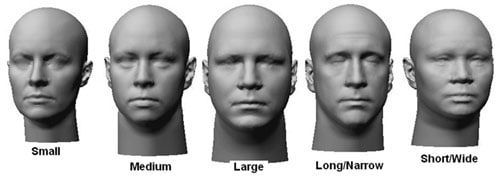NIOSH Anthropometric Data and ISO Digital Headforms
Updated April 24, 2020
NIOSH Anthropometric Data (2D and 3D)
In an effort to update the respirator test standards and fit test panels, The National Institute for Occupational Safety and Health (NIOSH) conducted a nationwide anthropometric survey of 3,997 subjects in 2003. Of the 3,997 subjects measured using traditional anthropometric techniques, surface scans and 26 three-dimensional (3D) landmark locations were collected for 947 subjects using a Cyberware 3-D Rapid Digitizer. The resulting head and face measurements of 3,997 subjects were used to develop a number of research publications which may be incorporated in future NIOSH standards for respiratory protection. In an assessment of the NIOSH Head-and-Face Anthropometric Survey of U.S. Respirator Users conducted in 2003, the Institute of Medicine affirmed that “Having effective respiratory protection can be, and often is, a matter of life and death. The scientific bases for developing and fitting effective respiratory protection remain more art than science.” Thus, NIOSH encourages additional analysis of the data and results to address occupational safety and health issues.
Details on the NIOSH data set are available in several publications, including Head-and-face Anthropometric Survey of U.S. Respirator Users [Z Zhuang and B Bradtmiller, J Occup Environ Hyg. 2005 Nov; 2(11):567-76]. Other research needs in respiratory protection are available in the NIOSH PPT Program Implementation Plan [PDF – 70 MB] and the NIOSH PPE for Healthcare Worker Action Plan [PDF – 122 KB]. The 2D and 3D data will be available from NIOSH for those who complete the data use agreements. To access the raw data, please visit the NIOSH Research and Statistics Gateway.
ISO Digital Headforms
Using anthropometric data gathered during the 2003 NIOSH survey, parameters for new headforms in five size categories were developed by the National Personal Protective Technology Laboratory (NPPTL) of NIOSH.
Three-dimensional (3D) scans of five individuals, who most closely represented a given size category were averaged together. The resulting models include facial features not found on current standard headforms. Five distinct sizes (small, medium, large, long/narrow and short/wide) of digital 3D headforms have been created taking into account the overall size and shape of the face. The NIOSH headforms are symmetric and represent the facial size and shape distribution of current U.S. respirator users. In addition, the ears have been placed on the headforms to match the average position for the chosen heads of a given size. These headforms have been incorporated into a technical specification standard for ISO TC94 Personal Protective Equipment, SC15 Respiratory Protective Devices, WG1 General, PG5 Human Factors. That standard is titled “ISO 16976-2 Respiratory Protective Devices — Human Factors — Part 2: Anthropometrics”. The five digital headforms are available in stl, ply, and igs format. Special software such as PolyWorks, Pro Engineering, and AutoCAD are required to open the files.

To access the digital headforms, please visit the NIOSH Research and Statistics Gateway.
